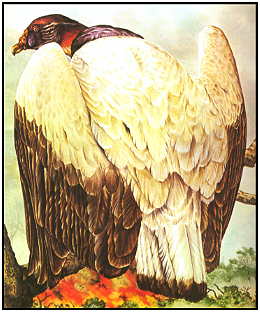PaintedOrder: Falconiformes. Family: Cathartidae. (New World vulture). Scientific Name: Sarcorhamphus sacra. Some debate surrounds this classification. Many people believe the Painted vulture was probably a relic of the King Vulture which simply became stranded in Florida. Others believe it was either a divergence of the King Vulture, or a completely separate species. The scientific name would change accordingly. Common Names: Painted Vulture. Conservation Status: Extinct c. 1800. We cannot be certain of the reason for extinction, but severe frosts may have contributed to the problem. The King Vulture suffers more from frosts than other old-world vultures and in 1913 a zoo specimen lost all of its toes to the cold; with the Painted Vulture being a relative it also may have had the same susceptibility. It has therefore been suggested that the movement of man into the Painted Vulture's territory simply hastened an inevitable extinction. Rescue & Recovery: Not applicable. Geographical Range: Florida, U.S.A. and possibly Carolina. Habitat: Meadows and Savannahs. Physical Characteristics: Described by the naturalist William Bartram in his book 'The Travels of...', as "a beautiful bird, near the size of a turkey buzzard, but his wings are much shorter, and consequently he falls much below that admirable bird in sail. I shall call this bird the painted vulture. The bill is long and straight almost to the point, when it is hooked or bent suddenly down and sharp; the neck and head nearly bare of feathers down to the stomach, when the feathers begin to cover the skin, , and it soon becomes long and of a soft texture, forming a ruf or tippet, in which the bird by contracting his neck can hide that as well as his head; the bare skin on the neck appears loose and wrinkled, which is of a deep bright yellow colour, intermixed with coral red; the hinderpart of the neck is nearly covered with short, stiff hair; and the skin of this part of the neck is of a dun purple colour, gradually becoming red as it approaches the yellow of the sides and forepart. The crown of the head is red; there are lobed lappets of redish-orange colour, which lay on the base of the upper mandible. But what is singular, a large portion of the stomach hangs down on the breast of the bird, in the likeness of a sack or wallet and seems to be a duplicature of the claw, which is naked and of a reddish flesh colour, unless when it is loaded with food, (which is commonly, I believe, roasted reptiles) and it then appears prominent. The plumage of the bird is generally white or cream colour, except the quill feathers of the wings and two or three rows of the coverts, which are of a beautiful dark brown; the tail which is large and white is tipped with this dark brown or black; the legs and feet of a clear white; the eye is encircled with a gold-coloured iris; the pupil black.
Painted VultureFood: Our only knowledge of this is Bartram's description of "roasted reptiles" in his published travels, along with some text from his original 'on the spot' notes, which stated that "When the vast meadows and Savannahs of Florida are set on fire, they gather in flocks to the new burnt ground where they feed on the roasted snake frogs lizards, turapins and other reptiles....." Reproduction: Unknown Other: This species was recorded in 1791, whether or not it truly ever existed cannot be validated. The issue has been the source of some hot debate and this is unlikely ever to be resolved. What is known is that this was the only confirmed sighting of the Painted Vulture. After his death Bartram was accused of being a liar and believers of this state he may have described a bird made up of the parts of a number of others, and that the painted vulture was completely mythical. Supporters of Bartram point out that he was known to be a man of great honesty, and was an exacting naturalist. With the exception of a couple of minor points, Bartram's description fits the King Vulture. It seems the Painted Vulture was smaller and had a longer bill; it was described as having a white tail and feet, whereas those of the King Vulture are black. The geographical location, too, was quite different as the King Vulture is found throughout Mexico and Argentina. assuming Bartram's observations of his Painted Vulture were correct, then experts agree he was right in assigning it a separate scientific name. In his notes Bartram also comments about having caught one of these birds, though if he did so, the later location of the specimen is not known. All
other records of this vulture are thought to have either been taken
from Bartram's records, or are unconfirmed. Du Pratz recorded a
vulture which was "smaller than the eagle of the Alps, but
it is a much finer bird, being almost entirely white, and having
only the extremity of its quills black. As it is rather rare, it
is prized among the natives, who pay a high price for the wing quills
as an adornment of the "peace-pipe"." It has been
determined that his writings were not based on Bartram's work, however
he provides little information on the vulture in question.
|

